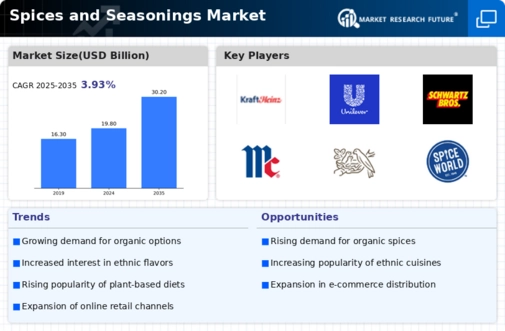Top Industry Leaders in the Spices Seasonings Market

The Spices and Seasonings market has witnessed dynamic growth in recent years, driven by changing consumer preferences, globalization, and an increasing demand for diverse culinary experiences. The competitive landscape of this market is characterized by a mix of established players, innovative startups, and evolving strategies to capture market share. As the industry continues to evolve, understanding the key players, their strategies, and the factors influencing market share becomes crucial for stakeholders.
Key Players and Market Share Analysis:
Ajinomoto Co. Inc
Olam International
Döhler Group
Associated British Foods PLC
The SHS Group
Ariake Japan Co. Ltd
Sensient Technologies Corp
Kerry Group PLC
B&G Foods Inc
McCormick & Company, Inc, among others
Strategies Adopted by Key Players: In the fiercely competitive Spices and Seasonings market, companies adopt various strategies to gain a competitive edge. Product innovation is a key focus, with players constantly introducing new flavors, blends, and packaging formats to meet the evolving tastes of consumers. Strategic partnerships and acquisitions are common, helping companies expand their product offerings, geographic presence, and market share. For instance, McCormick's acquisition of French's Food in 2017 strengthened its position in the condiments and seasonings segment. Additionally, marketing and branding play a crucial role, with companies investing heavily in promotions and advertising to create a strong brand image.
Factors Influencing Market Share: Several factors contribute to the determination of market share in the Spices and Seasonings industry. Quality of products, pricing strategies, distribution networks, and customer loyalty are key drivers. Brand reputation and recognition are significant factors influencing consumer choices, with trusted brands often commanding a larger market share. Furthermore, effective supply chain management and strategic alliances with retailers and distributors contribute to a company's ability to reach a broader consumer base and maintain a competitive position.
New and Emerging Companies: The Spices and Seasonings market is witnessing the emergence of new and innovative companies that are disrupting traditional norms. These startups focus on niche markets, unique flavor profiles, and sustainable sourcing practices. One such example is Burlap & Barrel, a company that directly sources spices from smallholder farmers around the world, offering rare and high-quality products. The rise of these smaller players introduces a dynamic element to the market, challenging established norms and providing consumers with diverse and authentic choices.
Industry News and Current Trends: The Spices and Seasonings market is not immune to the rapid changes and trends affecting the food industry as a whole. One notable trend is the increasing demand for organic and sustainable products. Consumers are becoming more conscious of the environmental impact and the origin of their food, leading to a growing preference for ethically sourced and eco-friendly spices and seasonings. Industry news often revolves around companies adapting to these trends, introducing organic product lines, and promoting sustainable practices in their supply chains.
Company Investment Trends: Investment trends in the Spices and Seasonings market reflect the industry's focus on innovation, technology, and sustainability. Key players are allocating significant resources to research and development, aiming to create unique and high-quality products. Additionally, investments in digital marketing and e-commerce platforms have become crucial as companies seek to connect directly with consumers and capitalize on the growing online shopping trend. Moreover, there is a notable trend of strategic investments in start-ups and smaller companies that bring innovative technologies or unique products to the market.
Overall Competitive Scenario: The competitive scenario in the Spices and Seasonings market is vibrant and ever-evolving. Established players continue to consolidate their positions through mergers and acquisitions, expanding their product portfolios and geographic presence. At the same time, new entrants are challenging the status quo, emphasizing sustainability, authenticity, and unique flavor profiles. The market's competitiveness is further intensified by changing consumer preferences, health and wellness trends, and the globalization of culinary tastes. As companies navigate this dynamic landscape, agility, innovation, and a deep understanding of consumer preferences will be critical to maintaining and enhancing their competitive positions. The Spices and Seasonings market is poised for continued growth, making it imperative for industry players to stay attuned to market dynamics and strategically adapt to emerging trends for sustained success.
Recent News:Top of Form
McCormick & Company:
Launched a new line of global-inspired spice blends featuring flavors from Morocco, Japan, and Argentina, tapping into the culinary travel trend.
Partnered with a leading grocery chain to launch a subscription box service offering curated spice collections and recipes.
Olam Food Ingredients:
Acquired a prominent black pepper processor in Vietnam, strengthening their position in the high-demand pepper market.
Developed a new line of sustainable and ethically sourced spices catering to consumers seeking responsible sourcing practices.
Kerry Group plc:
Invested in a startup creating artificial intelligence-powered flavor prediction technology, aiming to personalize seasonings and optimize taste profiles.
Announced plans to build a new spice processing facility in China, expanding their footprint in the Asian market.
Sensient Technologies Corporation:
Unveiled a new range of natural and organic flavoring solutions for plant-based meat alternatives, addressing the growing demand for meat-free options.
Partnered with a research institute to develop innovative spice extracts with potential health benefits, venturing into the realm of functional seasonings.











